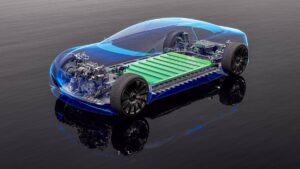Monsters of Rock: IGO watching midstream trend as it focuses in on lithium refinery ramp-up

Pic: HollenderX2/The Image Bank via Getty Images
- IGO is watching the emergence of midstream processing plans in Australia’s lithium sector
- But acting CEO Matt Dusci says the owner of the Greenbushes mine may still see more benefit in expanding its slow-moving hydroxide operations
- Nickel Industries says Indonesian battery nickel growth may be smaller than anticipated
Australian lithium miners are increasingly looking to the largely untested process of turning their products into an intermediate salt to export to refiners overseas as margin moves closer to the mine.
The theory is it would allow companies who baulk at the costs and lack of local expertise in chemical refining in Australia to capture some downstream value and reduce shipping volumes so they can sell into a longer haul western market and diversify from China.
It is a buzz topic in the electric vehicle supply chain as Pilbara Minerals (ASX:PLS) undertakes a $105 million trial to produce 3000tpa of lithium phosphate, MinRes (ASX:MIN) works toward the completion of a study this quarter on a lithium sulphate development and Liontown (ASX:LTR) considers the option as part of its downstream processing investigations.
Former Pilbara Minerals boss and chair of Canadian lithium explorer Patriot Battery Metals (ASX:PMT) Ken Brisden boldly claimed midstream products would displace spodumene over the next decade in a wide-ranging Q&A at this year’s Diggers and Dealers forum in Kalgoorlie.
IGO (ASX:IGO), which is way behind on the ramp up of its Kwinana lithium hydroxide JV with China’s Tianqi, its JV partner in the Greenbushes mine and Tianqi Lithium Energy Australia business, is open to considering other options to head into the refining games.
But spodumene remains a moneyspinner, given Greenbushes’ sector low costs, super high grades and world-leading 1.5mtpa concentrate production rate.
It’s cash machine status was confirmed today as IGO’s underlying profits lifted 258% to $1.528b, powered by a $1.184b dividend from its 24.99% share in Greenbushes.
Given the quality of the Greenbushes asset and proximity to Perth, acting CEO Matt Dusci told curious analysts on an earnings call today intermediates would need to stack up against what is a tight and tidy logistics route from Greenbushes to Kwinana, 35km south of Perth’s CBD.
“It’s probably a little bit early but we remain open to the different forms,” he said.
“Having said that, you have to remember that most of the savings you get from going to intermediates is associated with transportation and other elements.
“When you have Greenbushes located so close to your industrial hubs, then you may not see the same sort of (benefit) if you do … go into an intermediate.
“You also see Albemarle committing to that lithium hydroxide as well close to Greenbushes. So gives you an idea of where where those savings come from.”
IGO and Tianqi plan to hit 50% of Kwinana’s 24,000tpa capacity by the end of 2023, with an FID due next year on the development of a second train. Albemarle, however, has already committed to double its 50,000tpa Kemerton plant, also fed by con from Greenbushes.
“That can be done through a number of ways,” Dusci said on the company’s downstream plans.
“First priority is getting Train 1 up and performing to that 50% and beyond into calendar year ’24, making sure that we derisk Train 2 and then looking at Train 3 and 4 or how we drive value add maybe out of a sulphate etc.
“In parallel to that there (are) options potentially to toll treat if there were options outside of China.”
IGO (ASX:IGO) share price today
Nickel Industries warns not every Indonickel project will get up
Nickel Industries (ASX:NIC) boss Justin Werner has told analysts not all nickel projects and expansions in Indonesia will come to fruition as the market grapples with the rising spectre of oversupply of the battery and stainless steel ingredient.
The International Nickel Study Group has projected a potential 239,000t surplus in the nickel market this year with rising supply out of Indonesia causing an acceleration in the gulf between supply and demand.
After reporting a 102,500t surplus in 2022 the INSG reported the oversupply of nickel lifted from 17,100t in May to 27,400t in June.
NIC saw realised prices fall 21.5% from US$19,719/t to US$15,476/t in the first half of the year, with profit after tax falling 58.5% to $49.1m despite higher sales volumes leading to an 81% rise in revenue to $932.3m.
Its RKEF output rose from 26,733t on a 100% basis (21,386t on equity) in H1 2022 to 59,957t (45,843t) for the first half of 2023.
Tsingshan backed NIC issued at 2c per share interim dividend, the same as in 2022, as it looks to transition from supplying solely nickel pig iron to stainless steel producers to also producing nickel matte and MHP for electric vehicle batteries.
While it has seen nickel pig iron prices recover in the early part of the second half, Werner said the Indonesian Government was at the point of not sanctioning any more RKEF lines.
He said first-mover advantage would be important in HPAL for batteries as well.
“In terms of oversupply, I think what we’re seeing here is exactly what we saw in NPI. It will be a race, and those who aren’t at the front of the race will struggle to catch up if at all even be in the race,” he said on a call with analysts and investors.
“I was at a conference yesterday and the Indonesian Government is basically at the point of probably banning any further RKEF lines for the production of NPI. We are one of the largest producers of MPI outside of Tsingshan and we have an 80% interest across 12 RKEF lines.
“We’ve been able to build that up very quickly and very rapidly. As I said, our newer lines ANI and ONI are still making very, very strong margins, still around US$3,000 a tonne.”
The same thing could play out in the emerging class 1 nickel space, he warned.
“A lot of people are making announcements about HPAL and what actually gets built and funded, I think will be significantly less than what’s been announced and that will be for a number of different reasons,” Werner said.
“So again, we are looking to sort of stay ahead of the curve as we have been with NPI, as we were with nickel matte and as we look to do the same for HPAL.
“Again, we’ll be the first to produce not just MHP but nickel cathode and nickel sulphate. So I think that’s the key element here, too. We have product diversity, so we’re not just locked into a single market.”
The market for laterite ores was getting tighter, however, the company said, as the Indonesian Government cracked down on illegal mining.
Nickel Industries (ASX:NIC)

UNLOCK INSIGHTS
Discover the untold stories of emerging ASX stocks.
Daily news and expert analysis, it's free to subscribe.
By proceeding, you confirm you understand that we handle personal information in accordance with our Privacy Policy.








